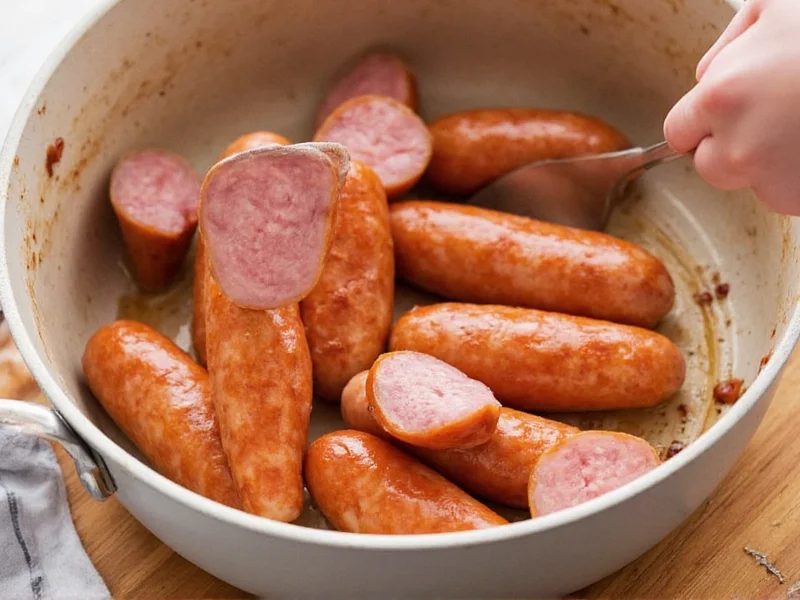Knowing the precise temperature to cook sausage is essential for both food safety and quality. Undercooked sausage poses serious health risks, while overcooked sausage becomes dry and unappetizing. The United States Department of Agriculture (USDA) and food safety experts universally recommend these temperature standards for home cooks.
Why Temperature Matters for Sausage Safety
Sausage presents unique food safety challenges compared to whole cuts of meat. During the grinding process, any bacteria present on the surface of the meat gets distributed throughout the product. This means sausage requires thorough cooking to eliminate potential pathogens like Salmonella, E. coli, and Trichinella.
Unlike steak where surface bacteria are killed during searing, sausage needs to reach a specific internal temperature to ensure safety. Relying on color or texture alone is unreliable—pork sausage can appear browned before reaching a safe temperature, while some sausages containing nitrites may retain a pink color even when fully cooked.
Sausage Temperature Guidelines by Type
Different sausage varieties require slightly different temperature targets based on their ingredients. Here's a comprehensive temperature reference:
| Sausage Type | Safe Internal Temperature | Special Considerations |
|---|---|---|
| Pork sausage (including bratwurst) | 160°F (71°C) | Hold temperature for at least 15 seconds |
| Beef sausage | 160°F (71°C) | Same standard as ground beef |
| Chicken or turkey sausage | 165°F (74°C) | Higher risk of Salmonella requires extra heat |
| Lamb sausage | 160°F (71°C) | Same standard as other ground meats |
| Pre-cooked sausages (heating only) | 140°F (60°C) | Only for reheating fully cooked products |
Proper Thermometer Technique for Sausage
Using a meat thermometer correctly is crucial for accurate readings. Many home cooks make mistakes that lead to unsafe or overcooked sausage:
- Insert properly: Place the thermometer probe into the thickest part of the sausage, avoiding contact with the cooking surface or bone
- Check multiple pieces: Test several sausages in a batch as cooking may be uneven
- Wait for stabilization: Leave the thermometer in place for 10-15 seconds until the reading stops changing
- Calibrate regularly: Test your thermometer in ice water (should read 32°F/0°C) or boiling water (212°F/100°C at sea level)
Digital instant-read thermometers provide the most accurate results for sausage cooking. Dial thermometers often lack the precision needed for thin sausage links. For best results, use a thermometer with a thin probe that can be inserted without causing significant juice loss.
Cooking Methods and Temperature Monitoring
Different cooking techniques require specific approaches to temperature monitoring:
Grilling Sausage
When grilling, move sausages to a cooler part of the grill once they've developed color. This prevents exterior burning before the interior reaches 160°F. Check temperature toward the end of cooking, rotating sausages to ensure even heat exposure.
Pan-Frying Sausage
For pan-frying, reduce heat after initial browning to allow heat to penetrate without burning the casing. Add a small amount of water and cover the pan for the final few minutes to create steam that helps cook the interior evenly.
Baking Sausage
When baking sausage in the oven, arrange links on a rack over a baking sheet to allow heat circulation. Rotate the baking sheet halfway through cooking for even results. Check temperature 5 minutes before the expected finish time.
The Resting Period: Critical for Perfect Sausage
After reaching the target temperature, remove sausages from heat and let them rest for 3-5 minutes. During this time:
- Residual heat continues to cook the sausage slightly (carryover cooking)
- Juices redistribute throughout the meat
- Internal temperature stabilizes at the ideal level
- Casing firms up slightly, improving texture
This brief resting period prevents juices from escaping when you cut into the sausage, resulting in a moister final product. Never skip this step when cooking sausage to proper temperature.
Common Temperature Mistakes to Avoid
Many home cooks make these critical errors when determining sausage doneness:
- Relying on color: Pink color doesn't necessarily mean undercooked, especially with nitrite-containing sausages
- Testing too early: Checking temperature repeatedly causes juice loss and uneven cooking
- Ignoring carryover cooking: Removing sausage too late results in overcooking during resting
- Using inaccurate thermometers: Old or uncalibrated thermometers give false readings
- Not checking multiple pieces: Assuming all sausages in a batch cook at the same rate
Remember that sausage continues cooking after removal from heat. For best results, remove sausages from heat when they reach 155-157°F (68-69°C), allowing them to reach the target 160°F during resting.
Special Considerations for Different Sausage Styles
Certain sausage varieties require special attention to temperature:
- Italian sausage: Contains fennel and other seasonings that can burn at high temperatures—cook gently to 160°F
- Breakfast sausage: Often more delicate—cook to 160°F but avoid pressing during cooking
- Bratwurst: Traditionally parboiled first, then finished to 160°F on the grill
- Smoked sausage: Often pre-cooked—only needs heating to 140°F unless specified otherwise
- Raw fermented sausages: Require specific temperature protocols beyond standard cooking guidelines
Always check packaging instructions for specialty sausages, as some artisanal or imported varieties may have different safety requirements.
Food Safety Beyond Temperature
While reaching the proper internal temperature is critical, other food safety practices matter too:
- Keep raw sausage refrigerated below 40°F (4°C) until ready to cook
- Prevent cross-contamination by using separate cutting boards for raw meat
- Wash hands thoroughly after handling raw sausage
- Don't leave cooked sausage at room temperature for more than 2 hours
- Store leftovers promptly in shallow containers for rapid cooling
Temperature is just one component of sausage food safety. Proper handling throughout the cooking process ensures you serve sausage that's both delicious and safe.











 浙公网安备
33010002000092号
浙公网安备
33010002000092号 浙B2-20120091-4
浙B2-20120091-4